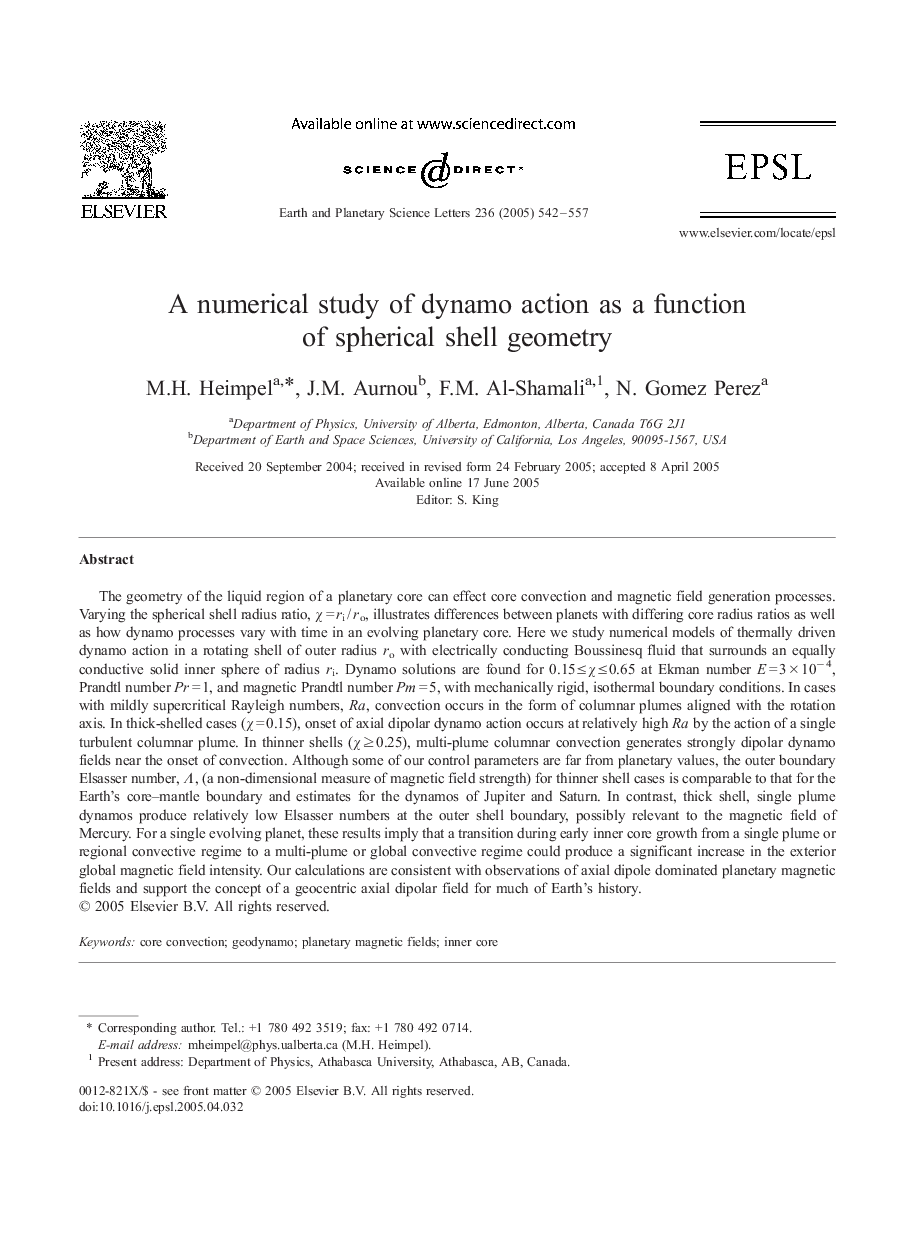| کد مقاله | کد نشریه | سال انتشار | مقاله انگلیسی | نسخه تمام متن |
|---|---|---|---|---|
| 9522166 | 1634962 | 2005 | 16 صفحه PDF | دانلود رایگان |
عنوان انگلیسی مقاله ISI
A numerical study of dynamo action as a function of spherical shell geometry
دانلود مقاله + سفارش ترجمه
دانلود مقاله ISI انگلیسی
رایگان برای ایرانیان
کلمات کلیدی
موضوعات مرتبط
مهندسی و علوم پایه
علوم زمین و سیارات
علوم زمین و سیاره ای (عمومی)
پیش نمایش صفحه اول مقاله

چکیده انگلیسی
The geometry of the liquid region of a planetary core can effect core convection and magnetic field generation processes. Varying the spherical shell radius ratio, Ï = ri / ro, illustrates differences between planets with differing core radius ratios as well as how dynamo processes vary with time in an evolving planetary core. Here we study numerical models of thermally driven dynamo action in a rotating shell of outer radius ro with electrically conducting Boussinesq fluid that surrounds an equally conductive solid inner sphere of radius ri. Dynamo solutions are found for 0.15 â¤Â Ï â¤Â 0.65 at Ekman number E = 3 Ã 10â 4, Prandtl number Pr = 1, and magnetic Prandtl number Pm = 5, with mechanically rigid, isothermal boundary conditions. In cases with mildly supercritical Rayleigh numbers, Ra, convection occurs in the form of columnar plumes aligned with the rotation axis. In thick-shelled cases (Ï = 0.15), onset of axial dipolar dynamo action occurs at relatively high Ra by the action of a single turbulent columnar plume. In thinner shells (Ï â¥Â 0.25), multi-plume columnar convection generates strongly dipolar dynamo fields near the onset of convection. Although some of our control parameters are far from planetary values, the outer boundary Elsasser number, Î, (a non-dimensional measure of magnetic field strength) for thinner shell cases is comparable to that for the Earth's core-mantle boundary and estimates for the dynamos of Jupiter and Saturn. In contrast, thick shell, single plume dynamos produce relatively low Elsasser numbers at the outer shell boundary, possibly relevant to the magnetic field of Mercury. For a single evolving planet, these results imply that a transition during early inner core growth from a single plume or regional convective regime to a multi-plume or global convective regime could produce a significant increase in the exterior global magnetic field intensity. Our calculations are consistent with observations of axial dipole dominated planetary magnetic fields and support the concept of a geocentric axial dipolar field for much of Earth's history.
ناشر
Database: Elsevier - ScienceDirect (ساینس دایرکت)
Journal: Earth and Planetary Science Letters - Volume 236, Issues 1â2, 30 July 2005, Pages 542-557
Journal: Earth and Planetary Science Letters - Volume 236, Issues 1â2, 30 July 2005, Pages 542-557
نویسندگان
M.H. Heimpel, J.M. Aurnou, F.M. Al-Shamali, N. Gomez Perez,